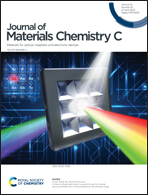Dominant dimer emission provides colour stability for red thermally activated delayed fluorescence emitter†
Abstract
Colour purity and stability in multi-donor thermally activated delayed fluorescence (TADF) emitters has significant implications for commercial organic light-emitting diode (OLED) design. The formation of emissive dimer states in the well-known 1,2,3,5-tetrakis(carbazol-9-yl)-4,6-dicyanobenzene (4CzIPN) chromophore at elevated dopant concentrations has recently been confirmed both experimentally and via theoretical calculations, indicating that multi-donor emitters such as 4CzIPN might suffer from a lack of colour stability due to the presence of multiple emissive states. This poses a serious issue for OLED manufacturers. In this work, dithieno[3,2-b:2′,3′-d]pyrrole (DTP) is applied as an alternative donor unit in a TADF emitter for the first time. In combination with isophthalonitrile (IPN), the 4CzIPN analogue termed 4DTPIPN is obtained. The strong electron donating nature of the DTP moiety gives rise to a red shift of the emission with respect to that of 4CzIPN. We identify that 4DTPIPN has a very stable emission spectrum throughout all solid-state thin film concentrations and host materials. Rather interestingly, this colour stability is obtained via the formation of dimer/aggregate species that are present even at 0.01 wt% concentration. Unfortunately, the higher colour stability is paired with a low photoluminescence quantum yield, making 4DTPIPN unviable for device applications. Nonetheless, this work shows the importance of dimer contributions, even at dilute doping concentrations. This molecule and study provide important understanding of the aggregation behaviour of small-molecule emitters necessary for the successful application of doped and, especially, non-doped OLED architectures.

- This article is part of the themed collection: Materials for thermally activated delayed fluorescence and/or triplet fusion upconversion


 Please wait while we load your content...
Please wait while we load your content...